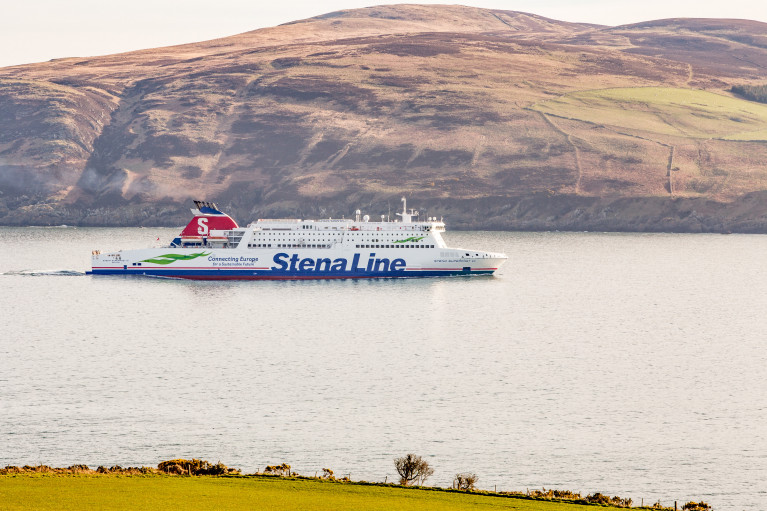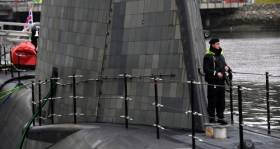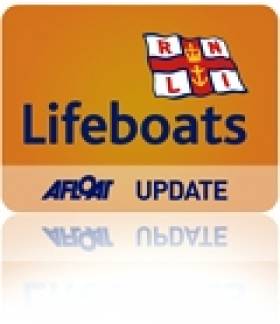Displaying items by tag: North Channel
Mixed Catamaran Olympic Medalists Aim to Set New North Channel Sailing Record Time
Ballyholme Yacht Club on the south shore of Belfast Lough will be the start point for a record-breaking trip across the North Channel to Portpatrick on the Mull of Galloway in Scotland during the week beginning 25th September.
Team GB Olympic silver medallists and World and European Champions in the Olympic Foiling Nacra17, John Gimson and Anna Burnett, will arrive at the club on Sunday 24th September.
In association with Artemis Foiling Technology, a zero-carbon passenger ferry that is being developed in Belfast, they will make an attempt at a record.
RYA UK and Artemis aim to have any achievement recognised by the Guinness Book of Records.
 John Gimson and Anna Burnett won world silver sailing medals at August's Allianz Sailing World Championships Photo: Sander van der Borch
John Gimson and Anna Burnett won world silver sailing medals at August's Allianz Sailing World Championships Photo: Sander van der Borch
The record stands at 1hr 41 mins 28 secs held by Ian Wilson and the late Johnny Mullan of Ballyholme Yacht Club in a Tornado catamaran in 1995. Richard Swanston, also of BYC holds the single-handed record of 1hr 50mins. He still sails a Multihull. And last year, Rob Espey sailed the crossing in a Waszp in 1 hour 30min, but it hadn’t been verified.
The trophy was donated by the late Bill Wallace’s family. Bill, Vera and their children, Heather, John and Peter all sailed a Dart 18.
The crossing is made complicated and dangerous with strong tidal influences on both sides of the channel, creating steep, difficult wave formations.
The foiling spectacular Nacra17 is capable of speed more than 25 knots, so if John and Anna can keep control, the record could fall.
Former Irish Rugby Star is Second Irish Woman to Complete Triple Crown of Open Water Swimming
A former Irish rugby international has become only the second Irish woman to complete the Triple Crown of Open Water Swimming.
Rosie Foley recently crossed 32.3km between Catalina Island and the mainland of Southern California to match the rugby union Triple Crown achieved by her late brother Anthony Foley.
It followed her nearly 46km circumnavigation of Manhattan Island this past June as she made an effort this year to complete the trifecta begun in 2014 with her 33.5km crossing of the English Channel.
Rosie, who embarked on the challenge in aid of the Mid-Western Cancer Foundation, children’s charity CARI and CRY, now joins an elite pantheon of open sea swimmers — fewer than 280 people have achieve the Triple Crown of Open Water Swimming.
Speaking about the, Rosie’s sister fellow marathon sports fundraiser Orla said: “Childhood sibling rivalry has helped many a sportsperson summit their Everest in life and even though he is dead nearly six years Anthony is still inspiring his family and others to reach for the stars.”
She adds: “In 2014, prior to Anthony’s death, Rosie achieved her childhood dream of swimming the English Channel and swimming the Shannon to Killaloe to which her younger brother quipped, ‘Have you ever heard of using a boat Rosie?’ or ‘There are easier ways to get to France – say a plane?’”
Closer to home, a new record was set for the North Channel as a 14-year-old Indian boy became the youngest person to swim the span between Scotland and the island of Ireland.
As the Times of India reports, NA Snehan from Theni in Tamil Nadu was part of a six-member team that swam from Northern Ireland to Portpatrick in Scotland in 14 hours and 39 minutes on Tuesday 20 September.
Snehan was exposed to cold-water swimming in his homeland to adjust to the chill of the North Channel, and as his coach Vijayakumar says: “He now aspires to undertake long-distance swimming across [the] English Channel, Gibraltar Strait and international channels.”
Ferry Firm P&O Plan Dog Friendly Lounges on Larne-Cairnryan Route
Operator P&O Ferries are planning to introduce dedicated dog lounges to their fleet, including ferries on their Larne-Cairnryan route.
The work to meet the needs of travellers with pets between Northern Ireland and Scotland, will be carried out as each of the present vessels is refitted. No completion date for work has been set as yet.
The dog lounges on P&O's Irish Sea ferries are expected to mirror the company's current Pet Lounge on their Dover to Calais route with indoor booths, TV, charging points and plugs, plus a dedicated steward and an enclosed exercise area. Travellers can upgrade to the P&O Pet Lounge for £12 each way.
DogsLive understands the P&O plan is in response to the increasing number of family dogs in the UK and Ireland and the move to a more dog-friendly society - but it will take time to put in place.
The news comes as Stena Line confirmed they are barring dogs from all passenger areas of their ferries from November 1. Instead all pets booked onto their ships must be stowed in a vehicle or booked into one of 12 metal kennels situated on the car deck.
Stena has apologised to customers and agreed to carry out a review to examine ways of improving existing onboard kennelling facilities. No date has been set for the review.
The change in Stena's regulations has come as a hammer blow to many dog owners, many of whom received phone calls from Stena staff to say their dogs were no longer welcome in passenger areas.
Much more reading reports Belfast Live on the carriage of dogs across the North Channel route.
Proposed Ireland-Scotland North Channel Bridge Another Profitable Winner For Feasibility Studies Industry
Anyone who has sailed regularly in the tide-riven and often stormy North Channel between Scotland and Ireland will have long realized that creating a permanent link – whether bridge or tunnel – would be one of the most demanding engineering challenges imaginable. Add to that the extreme depths in the mid-channel Beaufort Dyke - which happens to be filled with dumped World War II explosives – and you’ve something which would need thousands of fearless stuntmen to complete.
That said, longer bridges and tunnels have been constructed elsewhere. But those who enthuse about the North Channel link tend literally to look only at the surface, whereas those experienced in bridging and tunnelling will look underneath before they look at anything else.
So when the idea surfaced again a year or so ago as central to the new London government’s enthusiasm for an all-UK infrastructure improvement programme, the surface observers were all for it, but those who looked underneath to the sea bed anticipated that, in the end, the only beneficiaries would be the always-thriving Feasibility Studies Industry.
 Tunnel vision? The assumption that any fixed North Channel link would automatically go through the established ferry port of Larne ignored the fact that the route through Donaghadee to Portpatrick was significantly shorter.
Tunnel vision? The assumption that any fixed North Channel link would automatically go through the established ferry port of Larne ignored the fact that the route through Donaghadee to Portpatrick was significantly shorter.
Part of the problem was that the bridge or tunnel proponents seemed to assume - through tunnel vision presumably - that it would start from the Irish side near Larne in County Antrim, which for decades has been the principal ferry port, whereas on the main corridor the significantly shortest route to Portpatrick in Scotland is through Donaghadee and Great Copeland Island in County Down. But using that would - like the troublesome new HS2 rail route in southern England - cut straight through some of the choicest real estate, aka The Gold Coast, in Northern Ireland. So it was a non-starter, for even if the docile English will allow HS2 to desecrate some of their most cherished countryside, in North Down “Not An Inch” means just that.
Either way, the estimated costs of this idea were sky-rocketing by the minute, so the inevitable Feasibility Study was commissioned from some very respected transport executives, consultants and academics, and some time ago they regretfully concluded that even with the best of today’s technology, the cost would be prohibitively expensive, both now and for the foreseeable future.
Then yesterday, with much political brouhaha on other topics in London and Belfast as a distraction, the actual cost of that Feasibility Study was slipped under the radar into the public domain. It was £896,681, or €1,072,512 in real money, and it got some Scottish politicians ever so cross, as most of them have made clear their opinion that the whole idea was a serious waste of money at every level.
 Scottish politician Willie Rennie
Scottish politician Willie Rennie
Thus the Scottish Liberal Democratic economy spokesman Willie Rennie let fire with both barrels: “This is a gob-smacking sum to have spent on a PR stunt” said he. “It sounds like something that the Prime Minister came up with at 2 am at a Downing Street Party”.
Irish Sea Swimmers Set Record With North Channel Crossing for Charity
Six sea swimmers from Ireland have succeeded in their attempt to cross the North Channel in winter — setting a new record in the process.
According to RTÉ News, the members of the Walrus Swim Team completed the 35km relay swim from Donaghadee in Northern Ireland to Portpatrick in Scotland in just under 13 hours on Friday (14 January).
And what makes their achievement even more remarkable is that the sextet — who met while swimming at the Forty Foot in Dublin — took to the chilling waters of the North Channel without the protection of wetsuits.
A team of six swimmers from Ireland have set an historic record - completing the North Channel swim from Ireland to Scotland, without wet suits, in winter. ?♂️ ?♀️
— RTÉ News (@rtenews) January 15, 2022
The Walrus Swim Team finished the epic challenge in just under 13 hours yesterday evening. | https://t.co/HHmsjrJfFr pic.twitter.com/ZRu9h9LtQK
RTÉ News has more on the story HERE.
SeaMonitor Survey Deploying ‘Listening Stations’ to Track Marine Wildlife in North Channel This Week
The next SeaMonitor survey will be carried out by the RV Celtic Voyager in the North Channel from tomorrow, Wednesday 29 September.
This latest stage of the project aims to deploy 80 acoustic listening stations (ALSs) across the North Channel from Malin Head in Ireland to the Isle of Islay in Scotland between over four days, concluding on Saturday 2 October.
These stations will allow recording the presence of tagged marine wildlife including salmon, seals, cetaceans, basking shark and skate species, and provide evidence for conservation measures.
The SeaMonitor project is already ahead of schedule, as previously reported on Afloat.ie, with researchers from Nova Scotia in Canada carrying out expert field work using large-scale acoustic telemetry equipment.
This week’s survey operations will be carried out during daylight hours to facilitate a safe deployment of acoustic receivers on the seabed. The RV Celtic Voyager (callsign EIQN) will display appropriate lights and signals throughout.
For details on relevant locations and contact information, see Marine Notice No 54 of 2021 which can be downloaded below.
Ferry Sailings Operated by Stena Line Resume after Covid Cancellations
Ferry services run by Stena Line have resumed between Scotland and Northern Ireland, which were earlier disrupted due to a positive Covid-19 test among its crew.
One crew member on the Cairnryan to Larne ferry received a positive result from a lateral flow test, causing the company to take action on Wednesday.
It cancelled a number of sailings on Wednesday night and Thursday morning while the whole crew were tested.
No further cases were identified and sailings resumed with knock-on delays.
More from BBC News.
Submarine in 'Near-Miss' with Stena Ferry In Irish Sea
#ferries - A Royal Navy nuclear-powered submarine has been involved in a near-miss with a ferry in the Irish Sea.
An investigation writes The Irish Times, has been launched into the previously unreported incident, which occurred on November 6th.
The ferry was Stena Superfast VII, which operates between Northern Ireland and Scotland.
It has a capacity for 1,300 passengers and 660 cars.
The submarine was submerged at the depth needed to extend its periscope above the surface of the water.
The Royal Navy would not confirm which of its 10 submarines was involved.
They are all nuclear-powered but only four carry Trident nuclear missiles.
A spokesman for the Marine Accident Investigation Branch (MAIB) said: “In November, we were notified of a close-quarters incident between the ro-ro [roll-on/roll-off] ferry Stena Superfast VII and a submarine operating at periscope depth.
To read more on the incident involving the ferry that operates Belfast-Cairnryan (not Stranraer as published) in the newspaper click here.
Diving Bell Used To Repair Irish Sea Power Cable
#DivingBell - Engineers worked 82 feet beneath the surface of the North Channel to repair a seabed cable linking Northern Ireland's power grid with Scotland.
According to HeraldScotland, the repair crew used a diving bell style device to safely reach the site some 4km from the Scottish mainland and fix the break in the Moyle Interconnector.
The N-Sea 'incubator' design is a more modern version of the diving bell design used in the construction of Dublin's deep-water quays between the 1870s and 1950s.
Stranraer RNLI Rescues North Channel Drifters
#RNLI - Stranraer RNLI's lifeboat was dispatched by Belfast Coastguard on Friday evening (7 June) to rescue men from a stranded personal water craft on the rocks at Corsewall Point.
The men had been travelling on the water scooter across the North Channel from Ballycastle in Northern Ireland to Campbeltown in Scotland and back - a round trip of some 130km - but ran out of fuel on the return leg, and drifted to Corsewall on the north point of the Rhins of Galloway.
The RNLI Stranraer lifeboat launched at 5.20pm from Lady Bay and 20 minutes later arrived on scene, where they discovered that two of the men were cold and one had an ankle injury - although a conflicting report via the Belfast Coastguard says only two men were found.
The men were transferred safely on to the lifeboat and taken to Dally Bay, from where they were taken by road to Stranraer Accident and Emergency Hospital.
But as BBC News reports, they were beset by further problems on their return trip to Northern Ireland later that evening, when the private vessel on which they were travelling also ran out of fuel and had to be towed to Red Bay in Co Antrim.
Belfast Coastguard confirmed to the BBC that the men had been travelling on their water scooter with "no navigational aids" and that "they could not get a signal from their mobile phone".































































